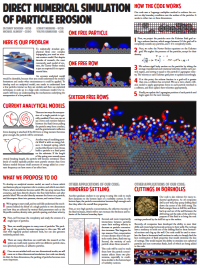CSDMS 2011 annual meeting poster Courtney Harris
Using a three-dimensional coupled sediment – hydrodynamic model to explore feedbacks between erodibility and sediment trapping in a partially mixed estuary, York River, VA
J. Paul Rinehimer, Applied Physics Lab, University of Washington Seattle Washington, USA.
Christopher Sherwood, US Geological Survey Woods Hole Massachusetts, USA.
Abstract:
The MUltiDisciplinary Benthic Exchange Dynamics (MUDBED) program explored the impact of physical and biological processes on turbidity and sediment properties in a muddy estuary. Hydrodynamics, settling velocity, and erodibility influence suspended sediment concentrations. In turn, flux convergence and divergence modify suspended sediment and seabed properties, thereby impacting Estuarine Turbidity Maxima (ETM). In partially mixed estuaries like the York River, VA variations in stratification and sediment trapping respond to tides, discharge, and winds, and produce a Secondary Turbidity Maxima (STM) that appears seasonally downstream of the main ETM.
A hydrodynamic and sediment-transport model of the York River was developed to examine feedbacks between sediment flux convergence, erodibility, and settling velocity. The Regional Ocean Modeling System (ROMS) was coupled to the Community Sediment Transport Modeling System (CSTMS). The model included bed consolidation by representing critical shear stress for erosion as increasing with depth in the bed and with time since deposition. Multiple grain types were used having settling velocities from 0.1 – 2.5 mm/s. Calculations of turbidity and erodibility showed similar patterns to observations and exhibited high spatial variability in both the along and across channel directions. Sediment trapping in the model led to the development of an erodible pool of sediment near the observed STM. Enhanced erodibility elevated suspended sediment concentrations in that area for some time after sediment convergence processes diminished. This poster will explore the behavior of the model and evaluate the use of the simplified bed consolidation model within a full three-dimensional numerical model.
* Please acknowledge the original contributors when you are using this material. If there are any copyright issues, please let us know and we will respond as soon as possible.

